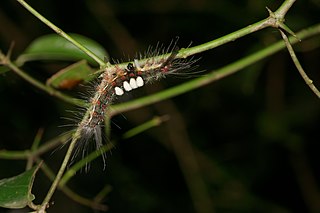
The Lymantriinae are a subfamily of moths of the family Erebidae. The taxon was erected by George Hampson in 1893.
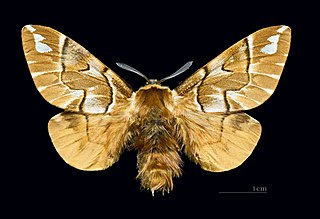
Endromidae is a family of moths. It was long considered to be a monotypic family, containing just one species, the Kentish glory, Endromis versicolora, found throughout the Palaearctic region. The family now consists of several genera and about 30 species, all former members of the family Bombycidae.
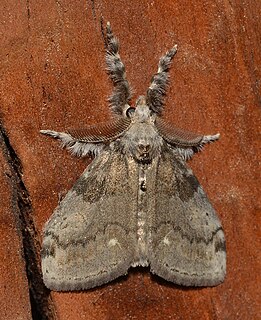
Orgyia leucostigma, the white-marked tussock moth, is a moth in the family Erebidae. The species was first described by James Edward Smith in 1797. The caterpillar is very common especially in late summer in eastern North America, extending as far west as Texas, California, and Alberta.

Orgyia is a genus of tussock moths of the family Erebidae. The genus was described by Ochsenheimer in 1810. The species are cosmopolitan, except for the Neotropical realm.

The Calpinae are a subfamily of moths in the family Erebidae described by Jean Baptiste Boisduval in 1840. This subfamily includes many species of moths that have a pointed and barbed proboscis adapted to piercing the skins of fruit to feed on juice, and in the case of the several Calyptra species of vampire moths, to piercing the skins of mammals to feed on blood. The subfamily contains some large moths with wingspans longer than 5 cm (2 in).

The Lasiocampinae are a subfamily of the moth family Lasiocampidae. The subfamily was described by Thaddeus William Harris in 1841.

Lymantria is a genus of tussock moths in the family Erebidae. They are widely distributed throughout Europe, Japan, India, Sri Lanka, Myanmar, Java, and Celebes. The genus was erected by Jacob Hübner in 1819.

Laspeyria is a genus of moths of the family Erebidae erected by Ernst Friedrich Germar in 1810.

Arctornis is a genus of tussock moths in the family Erebidae, and the sole member of the tribe Arctornithini. The genus was erected by Ernst Friedrich Germar in 1810.
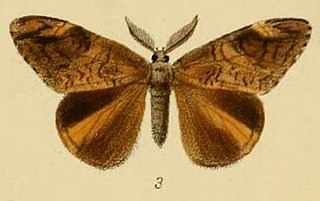
Aroa is a genus of moths in the subfamily Lymantriinae first described by Francis Walker in 1855. Species are distributed in South Africa, China, throughout India, Sri Lanka, Myanmar, and Java.
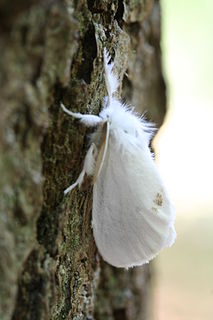
Sphrageidus is a genus of tussock moths in the family Erebidae. It is considered a synonym of the related genus Euproctis by some authors, but still recognized as valid by others (e.g.), and supported as distinct in molecular phylogenetic studies.

Gastropacha is a genus of moths in the family Lasiocampidae. It was first described by Ochsenheimer in 1810.

Telochurus recens, the scarce vapourer, is a moth of the subfamily Lymantriinae found in Europe. The species was first described by Jacob Hübner in 1819. The wingspan is 35 to 40 millimetres (1.4–1.6 in) for the males; the females are wingless. The moth flies from June to July depending on the location. The larvae feed on various deciduous trees, such as Crataegus and Salix species. This species has commonly been placed in the genus Orgyia but molecular analyses support its exclusion from that genus, and placement in the genus Telochurus.

Notodonta is a genus of moths of the family Notodontidae erected by Ferdinand Ochsenheimer in 1810.

Clethrogyna antiquoides is a moth of the family Erebidae. It is found in most of Europe, the Ural, Armenia, Mongolia, and China. This species has commonly been placed in the genus Orgyia but molecular analyses support the genus Clethrogyna as a separate lineage.

Orgyia postica, the cocoa tussock moth or hevea tussock moth, is a species of moth of the subfamily Lymantriinae of family Erebidae found from the Oriental tropics of India, Sri Lanka, Myanmar, Borneo, Java, New Guinea and Taiwan. It was described by Francis Walker in 1855.

Clethrogyna aurolimbata is a species of moth of the family Erebidae first described by Achille Guenée in 1835. It is found in the Pyrenees and on the Iberian Peninsula. The larvae feed on Genista species, including Genista purgans. This species has commonly been placed in the genus Orgyia but molecular analyses support the genus Clethrogyna as a separate lineage.

The Orgyiini are a tribe of tussock moths of the family Erebidae. The tribe was described by Wallengren in 1861.
Orgyia viridescens is a moth of the family Erebidae first described by Francis Walker in 1855. It is found in Sri Lanka.


















